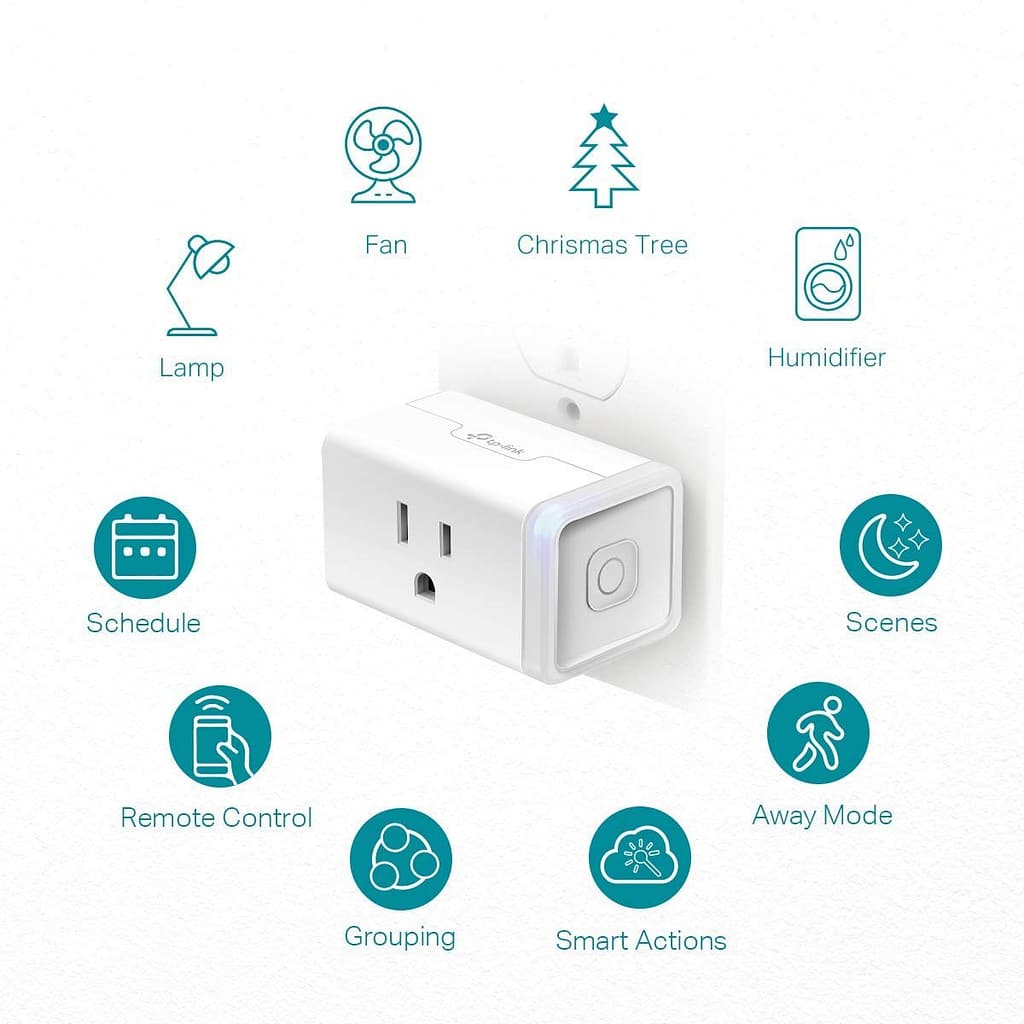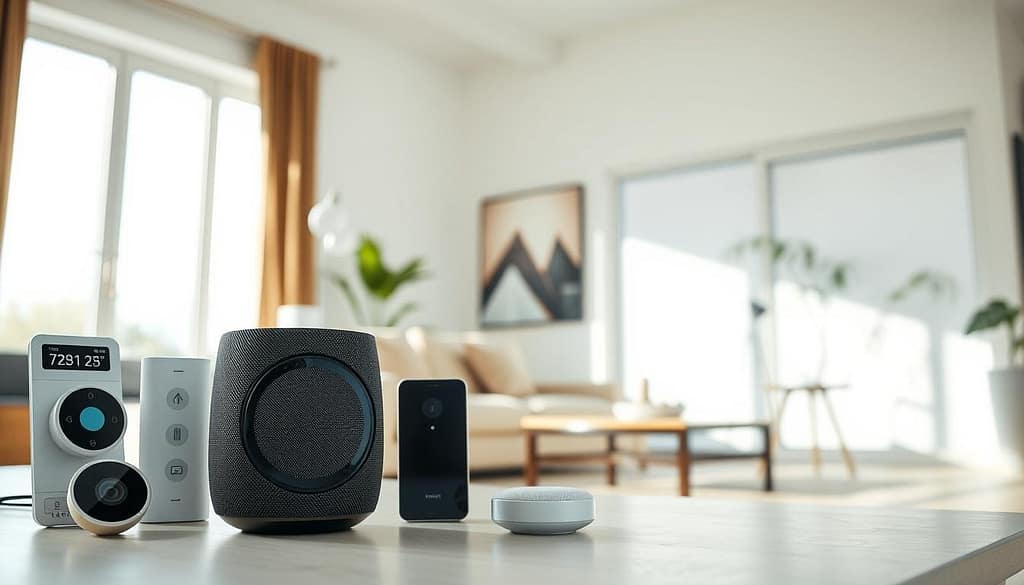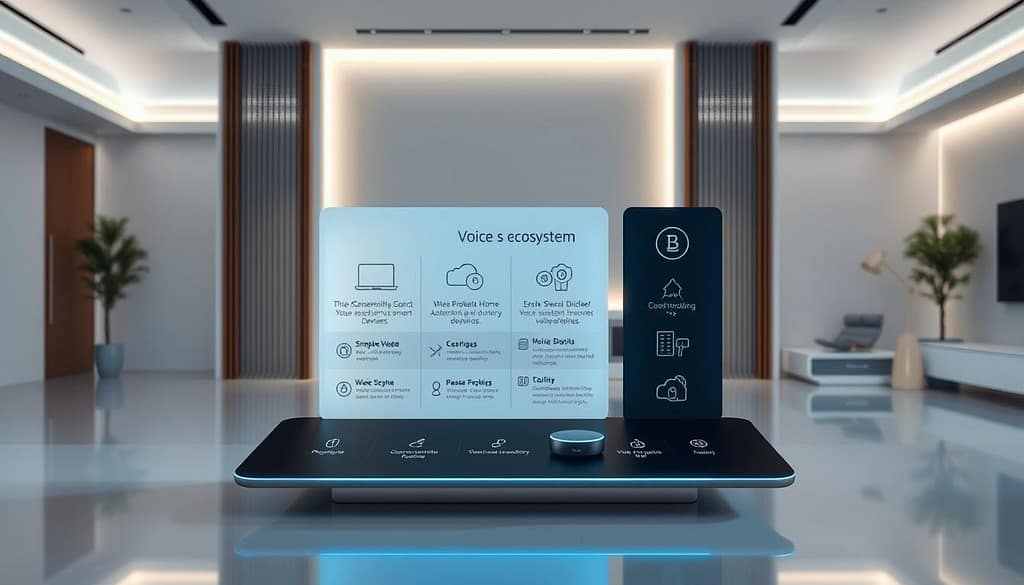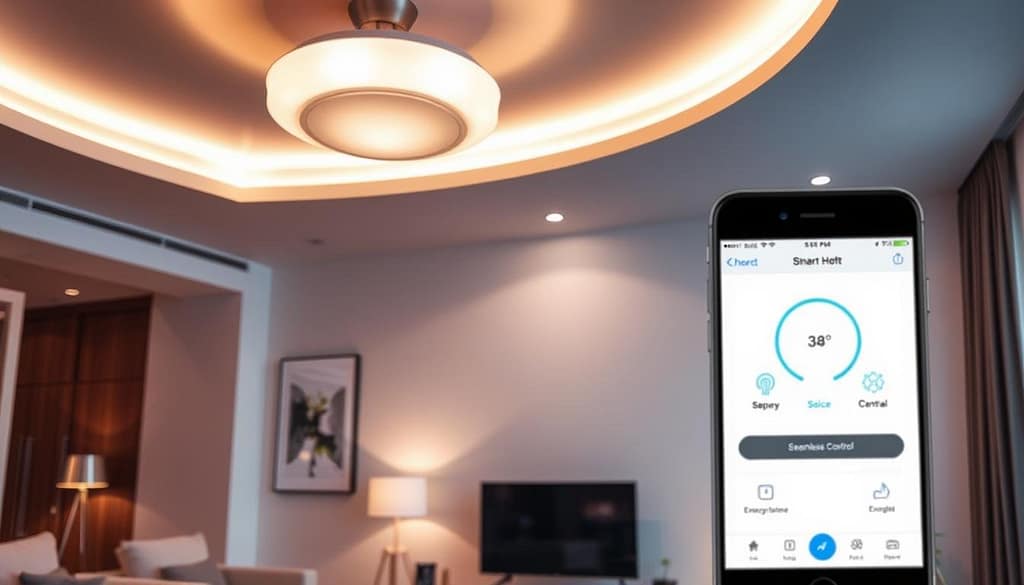Transforming your living space into a voice-controlled haven is now easier than ever. Devices like Amazon Echo and Google Home allow you to automate various aspects of your home. This includes lights, thermostats, and appliances, making everyday tasks more convenient. Integrating voice control into your smart home setup not only streamlines your daily routine but also enhances accessibility and comfort.
This guide is designed to walk you through the process. From choosing the right voice assistant to setting up your devices, we’ve got you covered.
Table of Contents
- 1 The Power of Voice-Controlled Smart Home Setup
- 2 Smart Home Setup: Picking the Perfect Voice Assistant Ecosystem
- 3 Echo Device Options and Capabilities
- 4 Alexa-Compatible Smart Home Brands
- 5 Smart Home Setup: Exploring Top Google Home Device Options
- 6 Google-Compatible Smart Home Brands
- 7 Smart Home Setup: Must-Have Devices for Beginners
- 8 Smart Home Setup: Easy Guide to Your Amazon Echo Device
- 9 Downloading the Alexa App
- 10 Wi-Fi Connection Process
- 11 Smart Home Setup: Quick Guide to Your Google Home Device
- 12 Downloading the Google Home App
- 13 Wi-Fi Connection Process
- 14 Smart Home Setup: Link Smart Lights to Voice Control with Ease
- 15 Connecting Lights to Alexa
- 16 Connecting Lights to Google Home
- 17 Smart Home Setup: Control Your Home Temperature with Voice
- 18 Alexa Thermostat Setup
- 19 Google Home Thermostat Setup
- 20 Smart Home Setup: Simplify Appliance Automation with Smart Plugs
- 21 Alexa Smart Plug Integration
- 22 Google Home Smart Plug Integration
- 23 Smart Home Setup: Craft Seamless Multi-Device Routines & Scenes
- 24 Schedule-Based Automation
- 25 Location-Based Triggers
- 26 Smart Home Setup: Fix Voice Control Issues Fast
- 27 Conclusion: Embracing the Smart Home Lifestyle
Key Takeaways
- Learn how to choose between Amazon Echo and Google Home for your smart home needs.
- Understand the basics of smart home automation and its benefits.
- Discover how to set up your voice assistant and integrate it with various smart devices.
- Explore the possibilities of controlling your home’s lighting, temperature, and appliances with voice commands.
- Get tips on maximizing the convenience and accessibility of your voice-controlled smart home.
The Power of Voice-Controlled Smart Home Setup
The introduction of voice-controlled smart home devices has revolutionized home automation. Homeowners can now control various aspects of their homes with just their voice. This has brought about a new level of convenience and accessibility.
What Makes a Home “Smart”
A home is considered “smart” when it’s equipped with devices that can be controlled remotely or automated. This includes lighting, temperature control, security systems, and entertainment systems. These devices form a network that can be managed efficiently, making life easier for those living there.
The Role of Voice Assistants in Home Automation
Voice assistants like Amazon Alexa and Google Assistant are key in home automation. They serve as the central hub for controlling various smart devices using voice commands. This eliminates the need for manual adjustments or using separate apps for each device, streamlining control.
Benefits of Voice Control for Everyday Tasks
Voice control offers numerous benefits for everyday tasks. It provides a hands-free way to operate lights, thermostats, door locks, and more. This is incredibly useful when your hands are full or when you’re in a different room. It also enhances accessibility for people with disabilities, making it easier for them to manage their home environment.
With over a quarter of US adults now owning a smart speaker, and this number predicted to rise, the trend towards voice-controlled smart homes is clear. As technology continues to evolve, we can expect even more sophisticated voice control features. These will further enhance the smart home experience.
This post contains affiliate links, and we may earn a commission if you purchase through them.
Smart Home Setup: Picking the Perfect Voice Assistant Ecosystem
A smart home setup begins with selecting the right voice assistant ecosystem. This choice greatly affects your smart home experience. It influences how you interact with devices and the level of automation achievable.
Amazon Alexa Ecosystem Overview
Amazon Alexa leads as a voice assistant, with a vast array of compatible devices and a robust ecosystem. It goes beyond basic voice commands, thanks to skills that enable interaction with various smart home devices.
Echo Device Options and Capabilities
Amazon offers a variety of Echo devices, each with unique features and capabilities. From the compact Echo Dot to the feature-rich Echo Show, there’s an Echo device for every need.
Alexa-Compatible Smart Home Brands
Alexa’s compatibility with numerous smart home brands makes it a versatile choice. Brands like Philips Hue, August, and Ring integrate seamlessly with Alexa, enabling full home automation.
Google Assistant Ecosystem Overview
Google Assistant is a powerful voice assistant that offers a sophisticated smart home experience. It understands complex commands and integrates with Google services, providing a robust home automation system.
Smart Home Setup: Exploring Top Google Home Device Options
Google’s range of Home devices, including the Google Home and Google Home Max, offer high-quality audio and intuitive voice control. These devices are designed to be the hub of your smart home.
Google-Compatible Smart Home Brands
Google Assistant supports a wide array of smart home devices from various brands, including Nest, Samsung, and LG. This compatibility ensures you can control multiple aspects of your home environment.
Making the Right Choice for Your Needs
When deciding between Amazon Alexa and Google Assistant, consider your existing devices, preferred brands, and specific features needed. Both ecosystems offer strong IoT integration capabilities. Your choice should be based on your individual needs and preferences.
Smart Home Setup: Must-Have Devices for Beginners
For beginners, understanding the core smart home devices is vital. These tools simplify life, boost home efficiency, and improve security. They are the foundation of home automation.
Smart Speakers and Displays
Smart speakers, like Amazon Echo and Google Home, are central to any smart home. They enable voice control over other devices, streamlining home management. Some models include displays, adding features like video watching and recipe access.
Smart Lighting Solutions
Smart lighting, including bulbs and strips, can be managed remotely or via voice. Brands like Philips Hue and LIFX provide products that adjust color, dim, or switch on/off. This enhances ambiance and saves energy.
Smart Plugs and Switches
Smart plugs and switches transform any appliance into a smart device. They can be controlled remotely or with voice commands. This makes managing power use easy. Reliable options are available from TP-Link and Belkin.
Smart Thermostats
Smart thermostats, such as Nest and Ecobee, adapt to your temperature needs. They optimize heating and cooling, ensuring comfort while saving energy. Control them via apps or voice assistants for seamless management.
This post contains affiliate links and we may earn a commission if you purchase through them.
Smart Home Setup: Easy Guide to Your Amazon Echo Device
The journey to a voice-controlled smart home starts with setting up your Amazon Echo device. This involves several easy steps to unlock your connected home’s full capabilities.
Unboxing and Initial Setup
First, unbox your Amazon Echo and plug it into a power source. Then, download the Alexa app on your smartphone or tablet. This app is key for configuring your device.
Downloading the Alexa App
Go to your device’s app store, search for “Alexa,” and download it. After installation, open the app and sign in with your Amazon account.
Wi-Fi Connection Process
Follow the app’s instructions to connect your Echo to Wi-Fi. Make sure to pick the right network and enter your Wi-Fi password correctly to finish the connection.
Configuring Basic Settings
After Wi-Fi connection, set up basic settings like your address and time zone. This info helps Alexa give you more tailored and relevant answers.
Testing Your Echo’s Voice Recognition
After setup, test your Echo’s voice recognition with simple commands. Try saying “Alexa, what’s the weather?” or “Alexa, play some music.”
Optimizing Speaker Placement
For the best sound, place your Echo in a central spot in your home. Keep it away from obstructions and other speakers. Try different spots to find the perfect one.
Smart Home Setup: Quick Guide to Your Google Home Device
To start using your Google Home, follow a few simple steps. This voice assistant can manage various smart home devices. It becomes the heart of your smart home setup.
Unboxing and Initial Setup
First, unbox your Google Home device. Then, download the Google Home app to begin the setup.
Downloading the Google Home App
To get the Google Home app, follow these steps:
- Open the Google Play Store on your Android or the App Store on your iOS.
- Search for “Google Home app.”
- Choose the Google Home app from the results and tap “Install.”
Wi-Fi Connection Process
After installing the app, connect your Google Home to Wi-Fi.
- Open the Google Home app.
- Tap “Add” and then “Set up device.”
- Follow the app’s instructions to connect to your Wi-Fi network.
Configuring Basic Settings
After Wi-Fi connection, set up basic settings like location and language.
Testing Your Google Home’s Voice Recognition
Test your Google Home’s voice recognition with simple commands. Try saying, “Hey Google, what’s the weather?”
Optimizing Speaker Placement
For the best sound, place your Google Home centrally. Keep it away from walls and corners.
| Setting | Description | Tips |
|---|---|---|
| Wi-Fi Connection | Connect Google Home to your network | Ensure a strong signal for better performance |
| Voice Recognition | Test Google Home’s ability to understand commands | Speak clearly and at a moderate pace |
| Speaker Placement | Position Google Home for optimal sound | Avoid placing near walls or in corners |
Smart Home Setup: Link Smart Lights to Voice Control with Ease
Integrating smart lights with voice assistants like Alexa and Google Home is a game-changer for home automation. This combination enhances your home’s ambiance, adds convenience, and boosts energy efficiency.
Popular Smart Bulb Options
Brands like Philips Hue and LIFX lead in smart lighting. They offer features such as color changing, dimming, and scheduling. These can all be controlled via voice commands.
Step-by-Step Connection Process
Connecting your smart lights to your voice assistant is straightforward. Here’s how you can do it:
Connecting Lights to Alexa
To connect your smart lights to Alexa, ensure they’re compatible. Then, follow these steps:
- Open the Alexa app and go to the “Devices” tab.
- Tap “+” and select “Add Device.”
- Choose “Light” and then select your light’s brand.
- Follow the on-screen instructions to complete the setup.
Connecting Lights to Google Home
For Google Home, the process is similar:
- Open the Google Home app and tap “Home Control.”
- Tap “+” and search for your light’s brand.
- Link your account and follow the prompts to complete the setup.
Creating Lighting Groups and Scenes
Once your lights are connected, you can create groups and scenes. For example, a “Dinner Party” scene can dim the lights and change their color. This creates a cozy atmosphere.
“The future of lighting is not just about illumination; it’s about creating an experience.”
Essential Voice Commands for Lighting
With your smart lights connected, you can use simple voice commands to control them. Examples include “Turn on the living room lights” or “Dim the kitchen lights to 50%.” Experimenting with different commands will help you discover the full range of your smart lighting system.
By integrating smart lights with voice control, you’re taking a significant step towards a more automated and convenient home. As you become more comfortable with the technology, you’ll find it simplifies your daily routines and enhances your living experience.
Smart Home Setup: Control Your Home Temperature with Voice
The rise of smart home technology has enabled us to adjust our home’s temperature with voice commands. This fusion of voice control with smart thermostats is transforming home comfort and energy use.
Smart Thermostat Installation Basics
To start voice-controlling your home’s temperature, you must first install a smart thermostat. Brands like Nest and Ecobee are popular for their simplicity and compatibility with voice assistants. Make sure to follow the manufacturer’s guide for installation, which usually involves swapping out your old thermostat for the new smart one.
Connecting Thermostats to Voice Assistants
After installing your smart thermostat, you must link it to your preferred voice assistant. The steps differ based on whether you’re using Amazon Alexa or Google Home.
Alexa Thermostat Setup
To connect your smart thermostat to Alexa, open the Alexa app and navigate to “Devices” and then “Thermostats.” Pick your thermostat brand and follow the on-screen instructions to link it. You can then manage your thermostat with voice commands through Alexa.
Google Home Thermostat Setup
For Google Home, start by opening the Google Home app and tapping “Home Control.” Then, hit the “+” icon to add a new device. Select your thermostat brand from the list and follow the prompts to connect it to Google Home. You can then adjust your thermostat using Google Assistant.
Temperature Control Voice Commands
Once your thermostat is connected to your voice assistant, you can use voice commands to change the temperature. For example, say, “Alexa, set the temperature to 72 degrees” or “Hey Google, turn up the heat.”
Creating Temperature Schedules and Routines
You can also set up schedules and routines to automate your thermostat. For example, you can program it to lower the temperature when you leave and raise it when you return. This can be managed through the voice assistant’s app or with voice commands to adjust the schedule instantly.
Smart Home Setup: Simplify Appliance Automation with Smart Plugs
The ability to automate any appliance using smart plugs is revolutionizing home automation. It makes it a key part of a voice-controlled smart home setup.

Selecting the Right Smart Plugs
When choosing smart plugs, consider compatibility with your existing voice assistant ecosystem. This includes Amazon Alexa or Google Home. Brands like TP-Link and Belkin offer reliable options that seamlessly integrate with various systems.
Setup and Connection Process
Setting up smart plugs is straightforward. First, plug the device into a power outlet. Then, connect it to your Wi-Fi network using the manufacturer’s app.
Alexa Smart Plug Integration
For Alexa integration, enable the smart plug’s skill in the Alexa app. Then, discover the device. This allows you to control the appliance using voice commands.
Google Home Smart Plug Integration
For Google Home, link the smart plug’s account in the Google Home app. The device will then be ready for voice control.
Voice Commands for Appliance Control
With smart plugs, you can turn appliances on or off. You can also schedule operations and create routines for complex automation scenarios.
Safety Considerations
Always check the maximum load capacity of the smart plug to avoid overloading. Ensure that the plug is certified by relevant safety standards.
| Brand | Compatibility | Max Load |
|---|---|---|
| TP-Link | Alexa, Google Home | 15A |
| Belkin | Alexa, Google Home | 12A |
Smart Home Setup: Craft Seamless Multi-Device Routines & Scenes
Smart home automation becomes even more powerful with customized routines and scenes. This feature lets you control various aspects of your home with just one command. It greatly enhances your smart home experience.
Morning and Evening Routine Examples
Daily routines can make life easier. For example, a “Good Morning” routine can turn on lights, adjust the thermostat, and play your favorite podcast. An “Evening” routine might dim the lights, lock doors, and play calming music.
Setting Up Routines in Alexa
To create a routine in Alexa, open the Alexa app and go to “Routines.” Tap the “+” icon to start. Choose triggers, like a voice command or schedule, and actions, such as turning on lights or adjusting the thermostat. Customize it to suit your needs.
Creating Routines in Google Home
In Google Home, open the app and navigate to “Routines.” Tap “Create a Routine” to begin. Define the trigger, like a voice command or time, and the actions, like controlling devices or sending messages.
Trigger Options Beyond Voice
Routines can be triggered by more than just voice commands. This adds to the automation.
Schedule-Based Automation
Schedule-based triggers let routines start at specific times or intervals. For instance, your “Good Morning” routine can start every day at 7 AM.
Location-Based Triggers
Location-based triggers use your phone’s GPS to activate routines at specific locations. This is handy for turning on lights when you arrive home.
Smart Home Setup: Fix Voice Control Issues Fast
Addressing voice control issues is key for a smooth smart home experience. Voice assistants, such as Amazon Alexa and Google Assistant, have transformed home automation. Yet, users often face problems that can hinder their convenience.
Connection Problems and Solutions
Connection issues between devices and voice assistants are common. Make sure all devices are on the same network. Also, ensure your voice assistant is set up correctly. Restarting devices can often fix connectivity problems.
Voice Recognition Challenges
Voice recognition problems can be a real challenge. Speak clearly and at a moderate pace to enhance recognition. Background noise can affect voice commands. Using a device with noise cancellation can help.
Device Compatibility Issues
Compatibility issues with devices are another frequent problem. Verify that your smart devices work with your chosen voice assistant. Some devices might need specific hubs or bridges for connection.
Privacy and Security Considerations
Privacy and security of your smart home are vital. Regularly update your devices’ firmware. Use strong, unique passwords for your accounts. Be mindful of the data you share with voice assistants.
This post contains affiliate links and we may earn a commission if you purchase through them.
Conclusion: Embracing the Smart Home Lifestyle
Integrating smart home technology into your daily life can greatly improve your comfort, convenience, and accessibility. Voice control and IoT integration allow you to manage your home’s ambiance, temperature, and appliances with ease.
Adopting a smart home lifestyle means enjoying a more streamlined and efficient living experience. Whether adjusting the lighting, playing your favorite music, or controlling the thermostat, voice assistants like Amazon Alexa and Google Assistant make it simple. They help you get things done without a hassle.
As you explore smart home technology further, you’ll find new ways to simplify and enhance your life. With the right devices and a bit of creativity, you can create a home that perfectly suits your needs and preferences.



